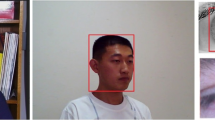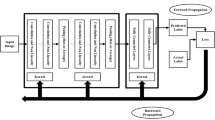Abstract
Biometrics are increasingly being used for tasks that involve sensitive or financial data. Hitherto, security on devices such as smartphones has not been a priority. Furthermore, users tend to ignore the security features in favour of more rapid access to the device. A bimodal system is proposed that enhances security by utilizing face and iris biometrics from a single image. The motivation behind this is the ability to acquire both biometrics simultaneously in one shot. The system’s biometric components: face, iris(es) and their fusion are evaluated. They are also compared to related studies. The best results were yielded by a proposed lightweight Convolutional Neural Network architecture, outperforming tuned VGG-16, Xception, SVM and the related works. The system shows advancements to ‘at-a-distance’ biometric recognition for limited and high computational capacity computing devices. All deep learning algorithms are provided with augmented data, included in the tuning process, enabling additional accuracy gains. Highlights include near-perfect fivefold cross-validation accuracy on the IITD-Iris dataset when performing identification. Verification tests were carried out on the challenging CASIA-Iris-Distance dataset and performed well on few training samples. The proposed system is practical for small or large amounts of training data and shows great promise for at-a-distance recognition and biometric fusion.
Supported by the National Research Foundation (120654). This work was undertaken in the Distributed Multimedia CoE at Rhodes University.
Access this chapter
Tax calculation will be finalised at checkout
Purchases are for personal use only
Similar content being viewed by others
Notes
- 1.
Memorizing and typing of secure passwords.
- 2.
Random search algorithm of Keras-Tuner was used.
- 3.
The smallest filter that captures left/right and up/down from a centre pixel’s perspective.
- 4.
Very low probabilities \(\le \) 0.04 worked best.
- 5.
1120 right-iris images from 224 subjects.
- 6.
The second block preferring double the dropout rate was a consistent trend.
References
Ammour, B., Bouden, T., Boubchir, L.: Face–iris multi-modal biometric system using multi-resolution Log-Gabor filter with spectral regression kernel discriminant analysis. IET Biometrics 7(5), 482–489 (2018), ISSN 2047-4938, 2047-4946, 10.1049/iet-bmt.2017.025
Brown, D., Bradshaw, K.: An investigation of face and fingerprint feature-fusion guidelines. In: Kozielski, S., Mrozek, D., Kasprowski, P., Małysiak-Mrozek, B., Kostrzewa, D. (eds.) Beyond Databases, Architectures and Structures. Advanced Technologies for Data Mining and Knowledge Discovery: 12th International Conference, Ustroń, Poland, May 31–June 3, 2016, Proceedings, pp. 585–599, Springer International Publishing (2016)
Brown, D., Bradshaw, K.: Improved palmprint segmentation for robust identification and verification. In: 2019 15th International Conference on Signal-Image Technology & Internet-Based Systems (SITIS), pp. 1–7, IEEE (2019)
Cho, S.R., Nam, G.P., Shin, K.Y., Nguyen, D.T., Pham, T.D., Lee, E.C., Park, K.R.: Periocular-based biometrics robust to eye rotation based on polar coordinates. Multimedia Tools and Applications 76(9), 11177–11197 (2017)
Chollet, F.: Xception: Deep learning with depthwise separable convolutions. In: Proceedings of the IEEE Conference on Computer Vision and Pattern Recognition, pp. 1251–1258 (2017)
Daugman, J.: Iris recognition border-crossing system in the UAE. Int. Airport Rev. 8(2) (2004)
Deng, J., Guo, J., Yuxiang, Z., Yu, J., Kotsia, I., Zafeiriou, S.: Retinaface: Single-stage dense face localisation in the wild. In: arxiv (2019)
Eskandari, M., Toygar, Ö.: Selection of optimized features and weights on face-iris fusion using distance images. Comput. Vis. Image Underst. 137, 63–75 (2015)
Guo, C., Pleiss, G., Sun, Y., Weinberger, K.Q.: On calibration of modern neural networks. arXiv:1706.04599 (2017)
Haghighat, M., Abdel-Mottaleb, M., Alhalabi, W.: Fully automatic face normalization and single sample face recognition in unconstrained environments. Expert Syst. Appl. 47, 23–34 (2016)
Jain, A., Hong, L., Pankanti, S.: Biometric identification. Communications of the ACM 43(2), 90–98 (2000a)
Jain, A.K., Prabhakar, S., Hong, L., Pankanti, S.: Filterbank-based fingerprint matching. IEEE Transactions on Image Processing 9(5), 846–859 (2000b)
Jamaludin, S., Zainal, N., Zaki, W.M.D.W.: Sub-iris technique for non-ideal iris recognition. Arabian J. Sci. Eng. 43(12), 7219–7228 (2018)
Kaur, G., Verma, C.: Comparative analysis of biometric modalities. Int. J. Adv. Res. Comput. Sci. Softw. Eng. 4(4), 603–613 (2014)
Kazemi, V., Sullivan, J.: One millisecond face alignment with an ensemble of regression trees. In: Proceedings of the IEEE Conference on Computer Vision and Pattern Recognition, pp. 1867–1874 (2014)
Kindt, E.J.: An introduction into the use of biometric technology. In: Privacy and Data Protection Issues of Biometric Applications: A Comparative Legal Analysis, pp. 15–85. Springer Netherlands (2013)
Kingma, D.P., Ba, J.: Adam: A method for stochastic optimization. arXiv:1412.6980 (2014)
Krizhevsky, A., Sutskever, I., Hinton, G.E.: Imagenet classification with deep convolutional neural networks. Commun. ACM 60(6), 84–90 (2017)
Kumar, A., Passi, A.: Comparison and combination of iris matchers for reliable personal authentication. Pattern Recogn. 43(3), 1016–1026 (2010)
LeCun, Y., Bengio, Y., Hinton, G.: Deep learning. Nature 521(7553), 436–444 (2015)
Rathgeb, C., Uhl, A., Wild, P.: Iris Biometrics: From Segmentation to Template Security, vol. 59. Springer Science & Business Media (2012)
Shekar, B., Bhat, S.S.: Iris recognition using partial sum of second order taylor series expansion. In: Proceedings of the Tenth Indian Conference on Computer Vision, Graphics and Image Processing, pp. 1–8 (2016)
Simonyan, K., Zisserman, A.: Very deep convolutional networks for large-scale image recognition. arXiv:1409.1556 (2014)
Song, J.M., Kim, W., Park, K.R.: Finger-vein recognition based on deep densenet using composite image. IEEE Access 7, 66845–66863 (2019)
Srivastava, N., Hinton, G., Krizhevsky, A., Sutskever, I., Salakhutdinov, R.: Dropout: a simple way to prevent neural networks from overfitting. J. Mach. Learn. Res. 15(1), 1929–1958 (2014)
Sundararajan, K., Woodard, D.L.: Deep Learning for Biometrics: A survey. ACM Comput. Surveys (CSUR) 51(3), 1–34 (2018)
Tan, T.: CASIA Iris Image Database. http://biometrics.idealtest.org/ (2016), [Online; Accessed 14-March-2016]
Tang, X., Du, D.K., He, Z., Liu, J.: Pyramidbox: A context-assisted single shot face detector. In: Proceedings of the European Conference on Computer Vision (ECCV), pp. 797–813 (2018)
Tang, Y.: Deep learning using support vector machines. Clin. Orthopaedics Related Res. (CoRR) 2 (2013)
Umer, S., Dhara, B.C., Chanda, B.: Iris recognition using multiscale morphologic features. Pattern Recogn. Lett. 65, 67–74 (2015)
Umer, S., Dhara, B.C., Chanda, B.: Nir and vw iris image recognition using ensemble of patch statistics features. Visual Comput. 35(9), 1327–1344 (2019)
Wang, K., Kumar, A.: Toward more accurate iris recognition using dilated residual features. IEEE Trans. Inf. Forensics Secur. 14(12), 3233–3245 (2019)
Wild, P., Hofbauer, H., Ferryman, J., Uhl, A.: Segmentation-level fusion for iris recognition. In: Proceedings of the International Conference on Biometrics Special Interest Group (BIOSIG), pp. 1–6. IEEE (2015)
Yang, J., Liu, Q., Zhang, K.: Stacked hourglass network for robust facial landmark localisation. In: Proceedings of the IEEE Conference on Computer Vision and Pattern Recognition Workshops, pp. 79–87 (2017)
Zhang, L., Zhang, L., Du, B.: Deep learning for remote sensing data: a technical tutorial on the state of the art. IEEE Geosci. Remote Sens. Mag. 4(2), 22–40 (2016)
Author information
Authors and Affiliations
Corresponding author
Editor information
Editors and Affiliations
Rights and permissions
Copyright information
© 2022 The Author(s), under exclusive license to Springer Nature Singapore Pte Ltd.
About this paper
Cite this paper
Brown, D. (2022). Deep Face-Iris Recognition Using Robust Image Segmentation and Hyperparameter Tuning. In: Smys, S., Bestak, R., Palanisamy, R., Kotuliak, I. (eds) Computer Networks and Inventive Communication Technologies . Lecture Notes on Data Engineering and Communications Technologies, vol 75. Springer, Singapore. https://doi.org/10.1007/978-981-16-3728-5_19
Download citation
DOI: https://doi.org/10.1007/978-981-16-3728-5_19
Published:
Publisher Name: Springer, Singapore
Print ISBN: 978-981-16-3727-8
Online ISBN: 978-981-16-3728-5
eBook Packages: EngineeringEngineering (R0)




